There are many different types of cracked teeth. Cracked teeth show a variety of symptoms, including erratic pain when chewing, possibly with release of biting pressure, or pain when your tooth is exposed to temperature extremes. In many cases, the pain may come and go, and your dentist may have difficulty locating which tooth is causing the discomfort. If you are experiencing these dental symptoms or suspect a cracked tooth, give us a call.
The treatment and outcome for your tooth depends on the type, location and extent of the crack. If you think you have a cracked tooth, it’s important to seek treatment quickly, before the problem gets worse. Once treated, most cracked teeth continue to function and provide years of comfortable chewing.
Understanding Cracked Tooth Symptoms and Treatment
Learn about the symptoms and types of cracked teeth and how endodontists help patients avoid tooth extraction.
How do I know if my tooth is cracked?
Cracked teeth show a variety of symptoms, including erratic pain when chewing, possibly with release of biting pressure, or pain when your tooth is exposed to temperature extremes. In many cases, the pain may come and go, and your dentist may have difficulty locating which tooth is causing the discomfort.
Why does a cracked tooth hurt?
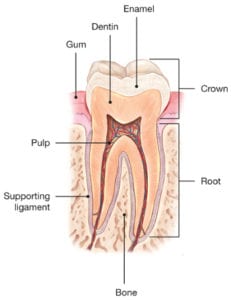 To understand why a cracked tooth hurts, it helps to know something about the anatomy of the tooth. Inside the tooth, under the white enamel and a hard layer called the dentin, is the inner soft tissue called the pulp. The pulp contains the tooth’s nerves and blood vessels.
To understand why a cracked tooth hurts, it helps to know something about the anatomy of the tooth. Inside the tooth, under the white enamel and a hard layer called the dentin, is the inner soft tissue called the pulp. The pulp contains the tooth’s nerves and blood vessels.
When the outer hard tissues of the tooth are cracked, chewing can cause movement of the pieces, and the pulp can become irritated. Eventually, the pulp will become damaged to the point that it can no longer heal itself.
The tooth will not only hurt when chewing but may also become sensitive to temperature extremes. In time, a cracked tooth may begin to hurt all by itself. Extensive cracks can lead to infection of the pulp tissue, which can spread to the bone and gum surrounding the tooth.
What if my tooth is chipped?
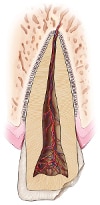 Chipped teeth account for the majority of dental injuries. Most chipped teeth can be repaired either by reattaching the broken piece of tooth enamel or by bonding a tooth-colored filling or crown in place. See your dentist as soon as possible after the injury to treat your chipped tooth and keep it from worsening.
Chipped teeth account for the majority of dental injuries. Most chipped teeth can be repaired either by reattaching the broken piece of tooth enamel or by bonding a tooth-colored filling or crown in place. See your dentist as soon as possible after the injury to treat your chipped tooth and keep it from worsening.
How will my cracked tooth be treated?
There are many different types of cracked teeth. The treatment and outcome for your tooth depends on the type, location and extent of the crack.
Craze Lines
Craze lines are tiny cracks that affect only the outer enamel. These cracks are extremely common in adult teeth. Craze lines are very shallow, cause no pain, and are of no concern beyond appearances.
Fractured Cusp
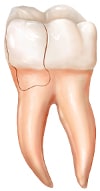 When a piece of a tooth’s chewing surface breaks off, often around a filling, it’s called a fractured cusp. A fractured cusp rarely damages the pulp, and usually doesn’t cause much pain. Your dentist can place a new filling or crown over the damaged tooth to protect it.
When a piece of a tooth’s chewing surface breaks off, often around a filling, it’s called a fractured cusp. A fractured cusp rarely damages the pulp, and usually doesn’t cause much pain. Your dentist can place a new filling or crown over the damaged tooth to protect it.
If you’ve cracked a tooth and breathing through your mouth or drinking cold fluids is painful, bite on clean, moist gauze or cloth to help relieve symptoms until reaching your dentist’s office. Never use topical oral pain medications (such as Anbesol®) or ointments, or place aspirin on the affected areas to eliminate pain symptoms.
Cracked Tooth
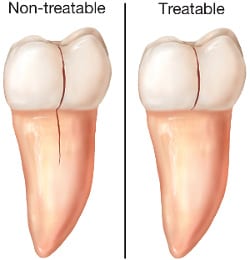 A cracked tooth means a crack extends from the chewing surface of your tooth vertically toward the root. The tooth is not yet separated into pieces, though the crack may gradually spread. Early diagnosis is important in order to save the tooth. If the crack has extended into the pulp, the tooth can be treated with a root canal procedure and a crown to protect the crack from spreading.
A cracked tooth means a crack extends from the chewing surface of your tooth vertically toward the root. The tooth is not yet separated into pieces, though the crack may gradually spread. Early diagnosis is important in order to save the tooth. If the crack has extended into the pulp, the tooth can be treated with a root canal procedure and a crown to protect the crack from spreading.
However, if the crack extends below the gum line, it is no longer treatable, and the tooth cannot be saved and will need to be extracted. That’s why early treatment is so important. A cracked tooth that is not treated will progressively worsen, eventually resulting in the loss of the tooth. Early diagnosis and treatment are essential in saving these teeth.
Split Tooth
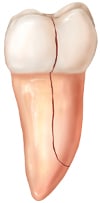 A split tooth is often the result of the long term progression of a cracked tooth. The split tooth is identified by a crack with distinct segments that can be separated. A split tooth cannot be saved intact. The position and extent of the crack, however, will determine whether any portion of the tooth can be saved. In some cases, endodontic treatment may be performed to save a portion of the tooth.
A split tooth is often the result of the long term progression of a cracked tooth. The split tooth is identified by a crack with distinct segments that can be separated. A split tooth cannot be saved intact. The position and extent of the crack, however, will determine whether any portion of the tooth can be saved. In some cases, endodontic treatment may be performed to save a portion of the tooth.
Vertical Root Fracture
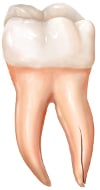 Vertical root fractures are cracks that begin in the root of the tooth and extend toward the chewing surface. They often show minimal signs and symptoms and may therefore go unnoticed for some time. Vertical root fractures are often discovered when the surrounding bone and gum become infected. Treatment may involve extraction of the tooth. However, endodontic surgery is sometimes appropriate if a tooth can be saved by removal of the fractured portion.
Vertical root fractures are cracks that begin in the root of the tooth and extend toward the chewing surface. They often show minimal signs and symptoms and may therefore go unnoticed for some time. Vertical root fractures are often discovered when the surrounding bone and gum become infected. Treatment may involve extraction of the tooth. However, endodontic surgery is sometimes appropriate if a tooth can be saved by removal of the fractured portion.
After treatment for a cracked tooth, will my tooth completely heal?
Unlike a broken bone, the fracture in a cracked tooth will not heal. In spite of treatment, some cracks may continue to progress and separate, resulting in loss of the tooth. Placement of a crown on a cracked tooth provides maximum protection but does not guarantee success in all cases.
The treatment you receive for your cracked tooth is important because it will relieve pain and reduce the likelihood that the crack will worsen. Once treated, most cracked teeth continue to function and provide years of comfortable chewing. Talk to your endodontist about your particular diagnosis and treatment recommendations.
What can I do to prevent my teeth from cracking?
While cracked teeth are not completely preventable, you can take some steps to make your teeth less susceptible to cracks.
- Don’t chew on hard objects such as ice, unpopped popcorn kernels or pens.
- Don’t clench or grind your teeth.
- If you clench or grind your teeth while you sleep, talk to your dentist about getting a retainer or other mouthguard to protect your teeth.
- Wear a mouthguard or protective mask when playing contact sports.
